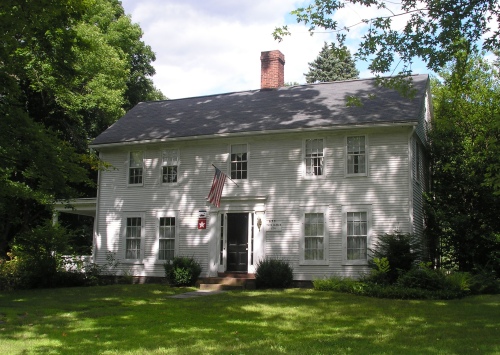Thomas Bliss II House (1717)

The Thomas Bliss II House in Longmeadow was built around 1717. In 1758, the house was converted into a tavern by Nathaniel Ely and served in that capacity until 1833. The house originally stood across Longmeadow Green from its current location. It was moved in 1855 to make way for the construction of Nathaniel Ely’s new mansion. Later in the nineteenth century, the house was lived in by Dr. Lester Noble, a dentist. He had a very interesting career, playing an important role in the famous Parkman Murder Trial. As described in “Our county and its people”: A history of Hampden County, Vol. I (1902), edited by Alfred Minott Copeland:
Dr. Lester Noble, now of Longmeadow, but formerly in active practice in Washington, D.C., and afterward of Springfield, is the oldest dental graduate in this vicinity. He studied with Dr. Keep of Boston, and was at one time a tutor at the Baltimore Dental college, from which he obtained his degree. Dr. Keep commenced practice in Longmeadow as early and perhaps earlier than 1840. He was employed in a spectacle factory and his first “victims” in the new art were his shopmates and their families. However, he soon went to Boston and became one of the most successful dentists in the country. It was in his office that the artificial dental plate was made for Dr. Parkman, who was murdered by Prof. Webster of Harvard college. By the testimony of Drs. Keep and Noble—then a student with Dr. Keep — Prof. Webster was convicted of the murder. This was the most noted murder trial of the time and in fact one of the most noted of all history. Dr. Noble, who made the plate, was summoned from the Baltimore Dental college—he then being a student there—and was able to produce the metal cast upon which the plate found among the remains of Dr. Parkman was made. The excitement that accompanied and followed the bringing into juxtaposition the plate and cast in the court, and the demonstration that each was the counter-part of the other, thus identifying the human fragments taken from the furnace of Prof. Webster’s, was dramatic in the extreme. Dr. Noble was demonstrator of mechanical dentistry at the Baltimore college during 1851-2 and in September, 1852, arranged an association with Dr. Maynard of Washington, which continued until 1859, when on account of poor health he was forced to give up practice for ten years. In 1869 he opened an office in this city, and for many years was one of our leading practitioners. He gave up active practice in 1898, and in that year the Valley District Dental society presented him with a memorial autograph album and listened to a very interesting paper of his reminiscences during the early days of the administration of ether, for his studentship started only one month after the first surgical operation under the influence of ether at the Massachusetts General hospital. Thus his studentship saw the advent of air chambers, the use of anaesthesia in surgery and the use of amalgam as a filling material. He prepared a paper on ” Personal Recollections of the early use of sulphuric ether as an anaesthetic,” which played no small part in clearing the misty atmosphere of those early days in reference to the real discoverer of anaesthesia. Dr. Noble is now an honorary member of the Massachusetts and Valley District Dental societies.
What us the address of the T. Bliss house. Thx.